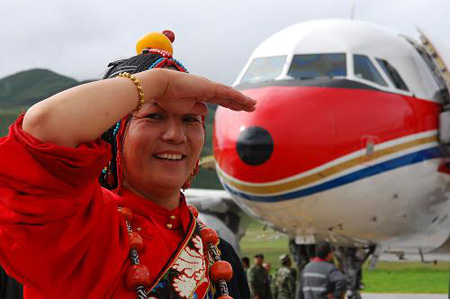Tourism in Qinghai's Tibetan area booming thanks to new airport
The operation of Batang Yushu Airport in Yushu Tibetan Autonomous Prefecture has offered a quicker and more convenient way to visitors to Yushu and the Sanjiangyuan Area in northwest China's Qinghai Province.
The local tourism industry, once restricted because of poor transport services, is now becoming increasingly prosperous. The areas have witnessed not only a large number of tourists in the peak tourist season, but also quite a few during the slack winter time.
|
|
|
A Tibtan woman poses for a picture by the first plane landing at the Batang Yushu Airport on Aug. 1, 2009. [Xinhua Photo] |
Yushu Tibetan Autonomous Prefecture accounts for nearly 20 percent of the total landmass of the Sanjiangyuan Area. Boasting the biggest number of highland wetlands, it is also home to high mountains and sources of well-known rivers, for instance, the Kunlun Mountains in the north, the Tonglha Mountains in the south, as well as the Yangtze, Yellow and Lancang rivers.
Since the opening of Batang Yushu Airport in August, the convenient flights to Yushu from elsewhere have made travel much easier for tourists.
According to Liu Lizhi, director of the Tourism Bureau of Yushu Tibetan Autonmous Region, from January to November, Yushu received 117,148 persons-time tourists, earning 60 million yuan (8.79 million U.S. dollars) from its tourism industry, up 87.5 percent and 90.62 percent year on year, respectively.
In August alone, the area had 25,969 persons-time tourists, earning 14 million yuan from the industry, a 120 percent and 133 percent rise from the same month in 2008.
In December, the prefectures received also quite a few tourists, most of whom came by air.
Taking the tourist resources of Yushu into consideration, the tourism bureau of Yushu will lay its emphasis on developing eco-tourism and promoting green economy, both in summer or winter, said Liu.
In addition to the unique and rich natural tourism resources, the Tourism Bureau will also highlight its religious culture in winter time, such as the largest Tibetan Buddhism stone carving festival on the Qinghai-Tibet Plateau, "Jiana Bangquan" Mani Stone Carving Festival.
Mani stones are stone plates, rocks or pebbles inscribed with the six syllable mantra of Avalokiteshvara as a form of prayer in Tibetan Buddhism.
Creating and carving such stones as a devotional or an intentional process art is a traditional way of showing Tibetan Buddhist believers' piety to the religion.
According to Liu, the festival is held in Yushu's Jiegu County on December 15 according to the Tibetan calendar. On the occasion, various cultural activities will be held, for example, presenting Mani stones and spinning Mani prayer wheels.
Meanwhile, tourism departments of Yushu also introduced an exploration to the sources of the three rivers during the winter season. Though weather conditions are harsher in winter than in summer, it is easier for visitors to reach the source as the frozen roads have fewer swamps, so that tourists will have the chance to enjoy more beautiful scenery along the way.
To make sure that tourists enjoy their stay in the area, the airport will offer two flights each week and star-rated hotels in Yushu will also operate as usual in winter.
 0 Comments
0 Comments








Comments